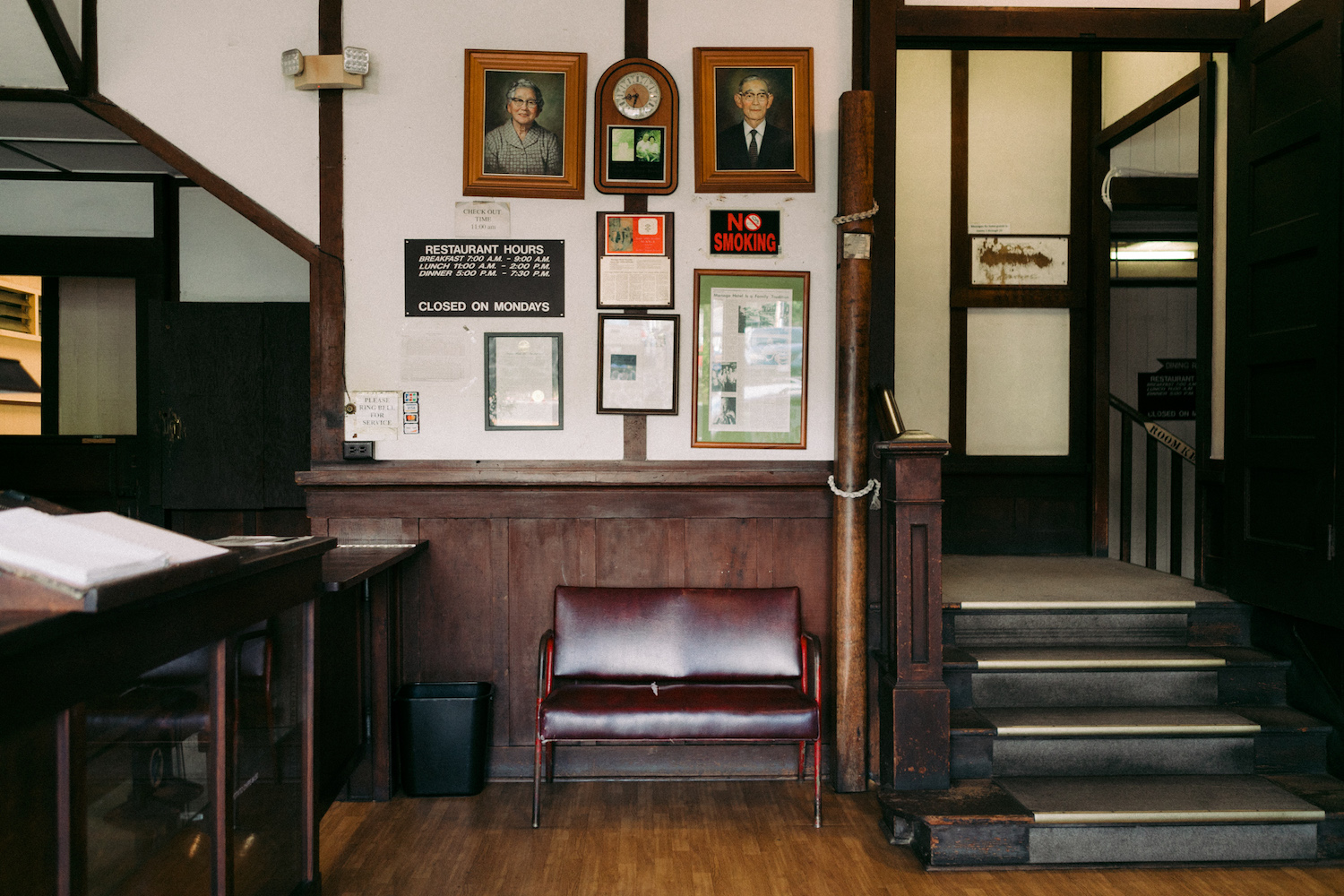A fourth generation of management is stepping up to lead this regional landmark.
A gray-haired woman stands beside Māmalahoa Highway across from Manago Hotel at sunset, pivoting on her feet until she finds the perfect angle for a photo of the cream-colored exterior and its neat row of second-floor windows over corrugated metal awnings.
Meanwhile, four visitors pause to look at antique bottles in the hotel window before entering the lobby, where manager Taryn Manago speaks to a couple of guests from behind the front desk. Minutes later, the vertical neon sign that rises from above the awning to the middle of the coffee-toned words “Manago Hotel” comes on, a glowing red, green, and blue beacon inviting everyone, whether they’ve crossed the road, island, or ocean, through the open doors.
Taryn and her younger sister Britney Manago are the fourth generation to manage Manago Hotel, the hotel and restaurant that have become a South Kona landmark. Their great-grandparents, Kinzo and Osame Manago, started the business in 1917 with a $100 loan from the man who employed Kinzo and Osame.
The couple bought and remodeled a house in Captain Cook, and began serving udon, bread, and coffee out of one of its two rooms.
When taxi drivers dropped off passengers at the nearby Paris Hotel and returned to the restaurant looking for a place to stay, Osame responded by offering them futons for 50 cents to a dollar.


Those drivers became regular overnight guests, and the couple, sensing an opportunity, grew their business.
Expansion and renovation in 1929 led to the building that stands today, and a three-story wing in the rear built in phases between 1959 and 1969 brought the total number of rooms to 64. The restaurant, a spacious area where customers dine at wood and Formica-topped tables, is the oldest continuously running restaurant in the state, according to the family.
In the century since Kinzo and Osame started the operation, Manago Hotel has become a reminder for regulars of their childhoods, and a chance for guests to experience a place born of a couple’s desire to serve their neighbors. For Taryn and Britney, the hotel has always been home.
Now in their 30s, the sisters are responsible for an institution with roots as deep as the region’s coffee trees. The two grew up playing in the hotel’s laundry room, running around in the gardens, and washing dishes. Britney recalls helping her grandfather Harold refill the candy case, count money, and refill the soda machine for a quarter each day.
“It was our normal,” Taryn said of growing up at the hotel.
Inside the hotel, portraits of Kinzo and Osame face the entrance, greeting everyone who comes in. Between them hangs a clock commemorating the 50th wedding anniversary of Taryn and Britney’s grandparents, Harold and Nancy Manago, the second generation to manage the hotel.
After the attack on Pearl Harbor, Harold returned home and met his father on the sidewalk, where Kinzo told him he’d be taking over the hotel the next day. While he was away in the Army during the war, Nancy helped Kinzo and Osame manage the hotel. News clippings and photos from the island’s past also adorn the lobby’s walls. To the right of the entryway, a glass case holds Kinzo’s old cameras.




Beyond the front desk is the restaurant, where a letter-board sign on the wall lists the menu, including its famous pork chops. Not only do visiting guests eat here, but so do local residents who grew up coming with their families and return with their own kids in tow. For many of them, a meal here is something between ritual and tradition. Decades ago, it was farm workers capping off days of coffee-picking with a cup of sake. Today’s customers include young parents sharing an early breakfast with their children before school starts.
Dwight and Cheryl Manago, Taryn and Britney’s parents, managed the business for the past 36 years, and they worked to maintain that feeling of nostalgia and keep Manago Hotel a place where people feel comfortable and welcome.
Too much change would risk alienating regulars, as Dwight learned when he returned to manage it in 1984 after working his way up from bar porter at O‘ahu’s then-Kahala Hilton to director of the food and beverage department at Hawai‘i Island’s Mauna Lani Bay Hotel. He came back with big plans to modernize the hotel, such as installing TVs and phones in the bedrooms. But regulars warned Dwight that if he changed things, they wouldn’t be his customers much longer.
Since Taryn’s return from O‘ahu, where she studied and worked in the restaurant industry, and Britney’s return from California, where she studied and worked in the hotel industry, they have made small changes, like getting the property onto third-party booking websites (though the reservation system itself is still handwritten).
The sisters aren’t eager to make change for the sake of change, given that much of what’s around them is older than they are. Just to the right of Kinzo’s portrait, for example, stands a wooden post from the Japanese room at the first hotel where the founding couple first offered refuge to passing travelers.


“This is my childhood,” Britney said. “This is how we grew up, and I like it the way it is. I don’t see the purpose of changing something if it works the way it works.”
“That’s the reason people come back, is to see it the same,” Taryn added.
Guests can still walk among the gardens with its rows of potted plants and look forward to a pork chop dinner. The Japanese room Harold Manago built for his mother still welcomes guests—it’s so popular that some will even re-book it a year in advance upon checking out—with tatami mats, shoji screens, and futon with a furo in the bathroom. And televisions are still absent from the bedrooms. Instead, there is a single set in a designated room across from the front desk.
Also constant has been each generation’s commitment to the business and its customers. Dwight’s mother, for example, worked seven days a week, rising at 4:30 a.m., and at times staying until 9 p.m. Sometimes the farthest she’d get from the hotel in a month, he remembers, was the front sidewalk.




“I think earlier in life we made a lot of sacrifice,” Dwight said. “My wife had to make a lot of sacrifice; our employees made a lot of sacrifice also. And that’s the reason we’re where it is today also. But would I have changed anything going back? I would probably say very few things, because I don’t regret anything that I’ve done.”
Taryn and Britney are recognizing more and more of their grandfather in their father these days, from the tasks he’s been taking on since they took over to the way he interacts with customers. “He won’t admit it, but everyone sees it,” Britney said with a laugh.
As dusk approaches, a middle-aged couple in the TV room holds hands during the final segment of CBS Weekend News and then switches to KHON2’s evening broadcast. As they do, a woman enters the hotel, leading by the hand an older woman wearing a floral dress and pāpale lauhala, the two followed closely by a man in an aloha shirt. They pass a photograph from 1920 of Honoka‘a plantation workers in suits, one of them sitting on a Crane Simplex Model 5 automobile parked in front of the original hotel.


By now, dinner service is well underway. The woman in the pāpale lauhala and her companions are the first to arrive at a table set for 12. Nine other tables are already full.
Many here are regulars, whom staff thank by name before they exit into the South Kona night. Others are here for the first time, their eyes scanning the menu on the wall as a server approaches with a bowl of rice and sides. In all likelihood, some will be regulars soon enough.


